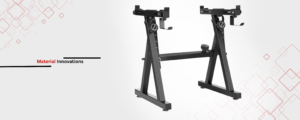The year is 2025, and the piano stand is no longer merely a support structure. It has become a sophisticated design that treasures the blend of art and technology. Alongside the stylish designs, pianos now come equipped with both digital and analog systems, leading to the reinvention of stands. The perfect piano stand is now flexible rather than rigid, strong rather than fragile, and works in conjunction with the piano and its surroundings. In this blog, I will look into how the function and the modern aesthetic of a piano stand integrate to meet the demands of today’s musicians. More specifically, I will analyze contemporary piano stands and their modern design.
To know more, read: Innovative Piano Stand Designs Set to Take Over in 2025
Core Design Principles
The sculptural frame incorporates the user’s comfort into the piano to the fullest extent by providing complete acoustic integrity alongside aesthetic coherence.
Ergonomic Adjustability:
The tilt and height settings of this model are customized to suit a wide variety of body types and playing techniques—but this is just the beginning. Unlike other models, this one incorporates wheels. As such, it is easier to move secondary chairs and other classroom furniture around, especially for the purposes of rearranging seating plans. Vertical and horizontal micro-adjustments guarantee that the keyboard rests at elbow level (around 28-30 inches). Pioneering automated hydraulic systems and manual spindle techniques provide these changes. In addition, brace capturing aids in achieving mimicking set forward and backward tilt easement of 5-15 degrees. So acting as the pivot point for dynamic performers, pivots/brackets allow uncapturable shifts to mimic grand pianos.
Weight Distribution & Stability:
The stands also do not wobble during vigorous playing because of reinforced crossbars, widened bases, and anti-slip rubber feet. Even weight distribution gives the stand, made of high-tensile steel or hardwood, a capacity of over 400 lbs.
Aesthetic Harmony:
The wood veneer and matte finish stands are eco-friendly and blend effortlessly into any contemporary space. To maintain visual aesthetics, all joints and cable management holes are designed to be hidden.
Key Functional Components
The usability of the 2025 piano stand is determined by ease of use and longevity innovations that come with the stand.
Multi-Tier Configurations:
Besides holding other keyboards, tablets, and even sheet music, modular tiers that serve are secondary surfaces can also store other items. Elements of layered performances and studio setups can quickly be done through clip-on or magnetic attachments.
Integrated Cable Management:
With incorporated cable management, power cords, MIDI cables, and audio interface cables can now be channeled & USB hubbed to reduce clutter. Obstructed surfaces with embedded wireless charging pads also frequently have greatly placed within.
No Compromise on Portability:
Due to the use of carbon-fiber composites and aluminum alloys, stands remain sturdy yet portable. For touring musicians, stands can be quickly assembled with foldable legs and quick-release locks.
Material Innovations
The 2025 piano stand is made from sustainable smart materials, marking a movement towards long-term sustainable use, not short-term.
Recycled and Biodegradable Composites:
Frames and accessories are now preferred to be made from reused metals like aluminum to form plant-based polymers. These materials are not as eco-friendly as traditional metals, but they are better.
Smart Composite Alloys:
Self-healing coatings offer scratch damage prevention, and vibration-dampening foam provides acoustical isolation. Memory alloys that change stiffness with temperature or pressure enhance stability.
Integration with Modern Pianos:
Piano stands are designed for model 2025, which integrates acoustic sound with digital features.
Compatibility With Acoustic-Digital Hybrid:
Hybrid-shaped and lightweight-structured pianos are best suited for changeable platforms. The body has ports for digital connections, while the open back aids in projecting the acoustic sound.
Smart Tech Synchronization:
Piano apps that are connected by Bluetooth allow the user to set the preferred height or angle position of the stand, making them freely adjustable. Posture monitoring is real-time suggestion making for active correction.
Design Future-Proofing
Adjusting the design for the piano stand in 2025 will have them following new trends and technologies in the market.
Future Strengthened Alternatives:
Entire components may be updated without replacing other parts; for example, pedalboards and tablet holders can be removed and changed.
AI Personalization:
Machine learning will allow for an ergonomic redesign suggested based on their habits. Wear and tear maintenance alerts will also be implemented.
Conclusion
In this era of innovation and underpinning tradition, the 2025 piano stand showcases a remarkable blend. Brands such as Roland, 5 Core, K&M and Donner are paving the way by creating solutions for acoustic puritans, digitalis and crossover users all at once. Eco-design, smart devices and the composable structure of materials set a new standard where contemporary physics is bound to advance innovation in music. The stands structure will allow them to silently assist in public performances and support the artist in all endeavors without drawing any attention.




